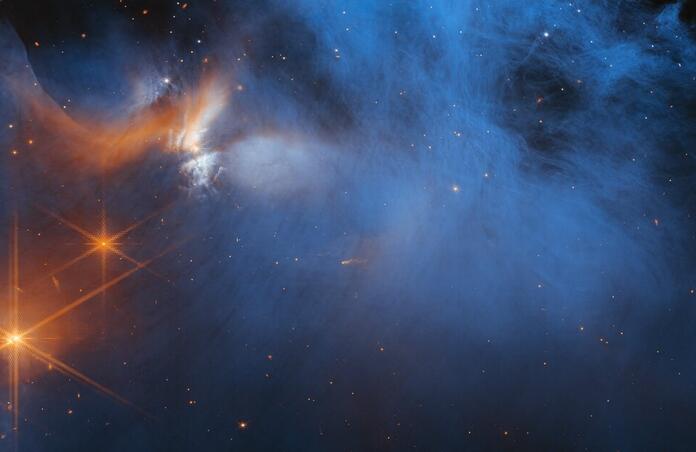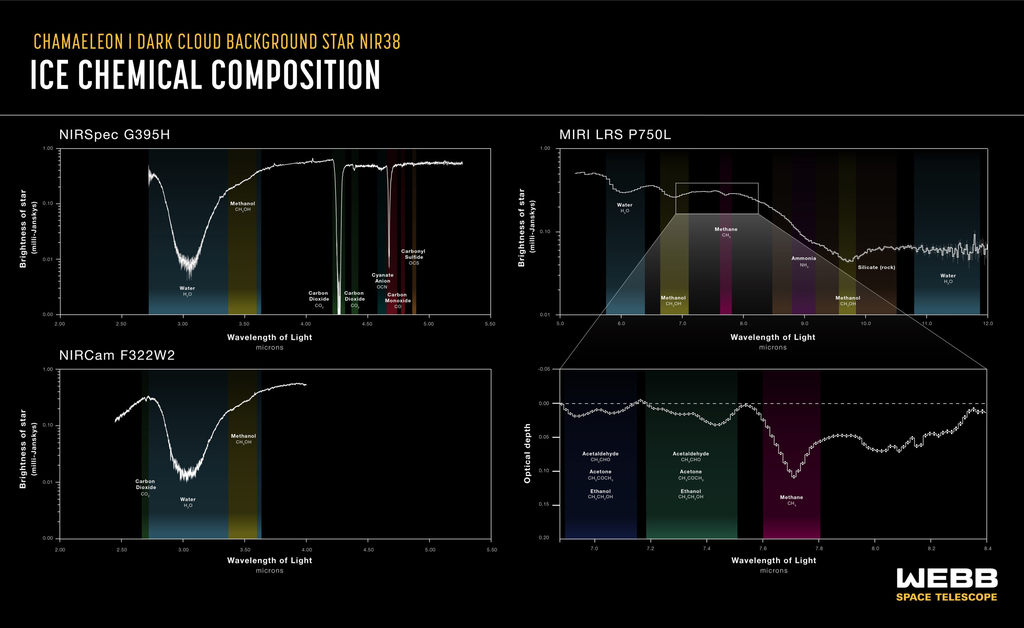Webb reveals chemistry of darkest interstellar ice ever imaged

The James Webb Space Telescope has once again lent a helping hand in the uncovering of ground-breaking astrophysical discoveries, this time imaging the darkest, densest clouds in the universe for the first time.
A group of international astronomers have used Webb to study the ices embedded deep into a particularly cold and dense region which is very difficult to investigate. The region is named the Chameleon I molecular cloud, situated roughly 500 light years from Earth in the southern constellation of chameleon. This region is part of a group of what astronomers once believed to be holes in the sky. However, these void spaces are dark molecular clouds, extremely dense areas filled with gas and dust such that any background starlight isn’t able to penetrate them. These clouds are the birthing places for stars; due to gravitational collapse, stars and eventually planetary systems form. Therefore, the chemical compositions of these regions can provide vital information about the makeup of future stars and exoplanets, however, these compositions can only be determined from the ices buried deep inside the cloud.

The team used two background stars dubbed NIR38 and J110621 to study the Chameleon I region in infrared wavelengths. By studying the spectra of starlight beyond the molecular cloud, absorption lines can be seen at specific wavelengths that are representative of the clouds’ molecular composition. After comparing this observed spectrum to laboratory data, it was found that arctic forms of a wide range of molecules were identified, from simple life-supporting components such as water, carbon dioxide, carbon monoxide, ammonia and methane, to the more complex organic molecule methanol. This is the most extensive census of the icy building blocks of stars and planets before the heating stage during young star formation.
"Our results provide insights into the initial, dark chemistry stage of the formation of ice on the interstellar dust grains that will grow into the centimeter-sized pebbles from which planets form in disks," said Melissa McClure, an astronomer at Leiden Observatory, Netherlands, and the lead author of the study. Additionally, the team found evidence for molecules more complex than methanol. Despite the fact that these signals weren’t definitively assigned to specific molecules, it is proof that complex molecules form in cold molecular clouds before the birth of stars.
Along with the number of molecules detected, carbonyl sulfide was also identified. From this, the group was able to estimate the abundance of sulfur within the frosty dust grains and discovered that although the amount measured is larger than that previously observed, this value is still much less than the amount expected to be present in the cloud due to its density. In fact, the ices contained only 1% of the expected sulfur. This means that the other 99% is locked up elsewhere, and finding the home of this mysterious missing sulfur will prove to be the next challenge for astronomers. It was proposed that the element is locked up in reactive minerals e.g iron sulfide, which can react with ices to form the observed grains.
"Iron sulfide is a highly reactive mineral that has been detected in the accretion disks of young stars and in samples returned from comets. It's also the most common sulfide mineral in lunar rocks," Dr. Danna Qasim, explains, co-author of the study. "If sulfur is locked up in these minerals, that could explain the low amount of sulfur in interstellar ices, which has implications for where sulfur is stored in our Solar System. For example, the atmosphere of Venus has sulfur-containing molecules, in which the sulfur could have partially come from interstellar-inherited minerals."
This problem also holds true for other elements vital to form habitable planets, dubbed the CHONS elements. They may be hiding in ice, soot-like materials or rocks, therefore, finding the amounts of these constituents in each will tell astronomers the fraction of the elements which end up in exoplanet atmospheres and interiors. “The fact that we haven't seen all of the CHONS that we expect may indicate that they are locked up in more rocky or sooty materials that we cannot measure," said McClure. "This could allow a greater diversity in the bulk composition of terrestrial planets."
This study is part of the Ice Age project, making up one of 13 early-release science programs by Webb. These observations are created to illustrate the telescopes' observing capabilities, allowing the community to learn how to optimise the use of its instruments. The team has already planned further observations, along with using the current data to calculate the sizes and shapes of the icy dust grains in the coming months. This will hope to trace the journey of pre-stellar ices from their formation to forming icy comets or becoming embedded in stellar and exoplanet cores and atmospheres.
--
Cover image: NASA, ESA, CSA, and M. Zamani (ESA/Webb); Science: F. Sun (Steward Observatory), Z. Smith (Open University), and the Ice Age ERS Team.
Journal source: Melissa McClure, An Ice Age JWST inventory of dense molecular cloud ices, Nature Astronomy (2023). DOI: 10.1038/s41550-022-01875-w. www.nature.com/articles/s41550-022-01875-w
